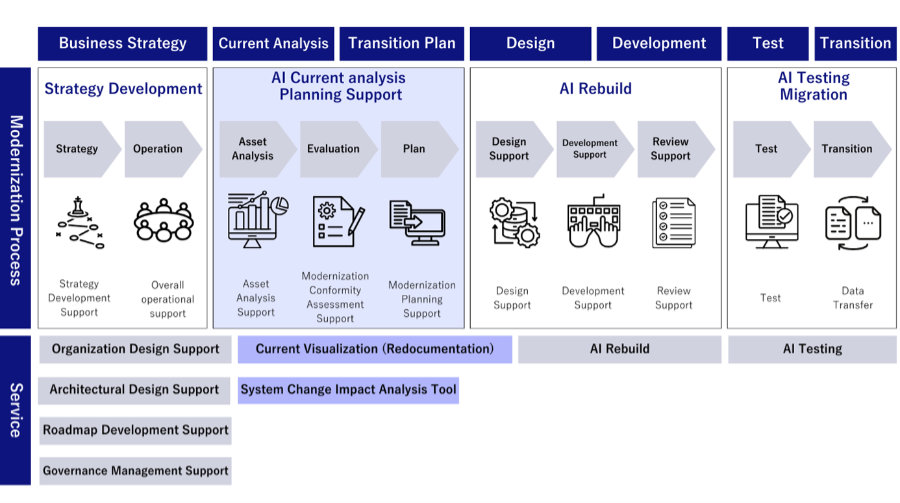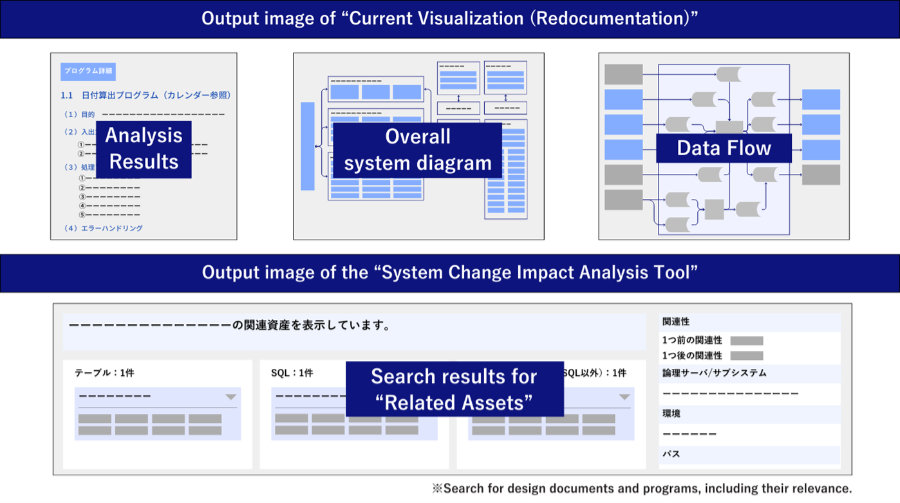Tokyo, March 11, 2025 – Nomura Research Institute, Ltd. (Headquarters: Tokyo, President & CEO Kaga Yanagisawa, “NRI”) launched the AI-Powered “Current System Visualization and System Change Impact Analysis Service” (“Service”) to help corporations navigate legacy system1 modernization2 ahead of the "2025 Cliff," a period , announced by METI(Ministry of Economy, Trade and Industry in Japan) ,marked by the increasing risks associated with outdated legacy systems, including end-of-support for critical software, rising maintenance costs, and a growing shortage of engineers skilled in legacy technologies.
The "2025 Cliff" refers to the looming risks businesses face due to outdated legacy systems, including increased maintenance costs, security vulnerabilities, and a shortage of skilled engineers. Leveraging NRI’s expertise and AI technology, the Service provides a comprehensive view of existing systems, analyzing the potential impact of changes. This innovative approach enables businesses to plan modernization efficiently and achieve sustainable system transformation.
Figure1: Overview of Modernization and the Scope of the Current System Visualization and System Change impact analysis Service

The Critical Role of “Current System Visualization” in Modernization Success
Effective current system visualization is crucial for the success of modernization efforts. This process involves mapping out the full structure of existing systems, detailing functions, and analyzing data flows. However, many corporations struggle with accumulated technical debt3 and system complexity, making visualization a challenge. Outdated system documentation—often a mix of incomplete records, handwritten notes, and scattered files in Excel, Word, and other formats—leads to missing key functions and unclear interdependencies. This lack of clarity increases the risk of defects, rising response costs, and schedule overruns.
AI-Powered “Re-Documentation” for High-Quality System Visualization
A key aspect of system visualization is Re-Documentation—extracting critical information from existing design specifications, code, and manuals to create structured, usable documentation for modernization. NRI leverages AI to streamline this process, enabling accurate systemwide data flow analysis and code dependency analysis.
By using AI, companies can:
- Rapidly analyze and structure documentation spread across diverse formats.
- Improve modernization planning with high-quality insights.
- Transition to advanced, efficient platforms with optimized strategies.
NRI has already delivered AI-powered Re-Documentation to numerous companies, helping them gain clear system insights and accelerate their modernization journeys.
System Change Impact Analysis Tool: Identifying System Change Effects in Real Time
This tool assesses how the system changes affect interconnected components, ensuring a seamless transition. NRI’s System Change Impact Analysis Tool visualizes relationships between system assets, instantly revealing the scope of impact and system dependencies. This tool correlates vast amounts of code and system decimation and provides a detailed map of how changes propagate though the system. With this tool, businesses can:
- Quickly pinpoint affected areas.
- Accurately estimate workloads.
- Minimize risks of defects and failures.
NRI has successfully implemented this tool for internal system development, streamlining modernization and failure analysis processes.
Figure2: Output Image of the Current System Visualization and System Change impact analysis Service

NRI continues to enhance modernization support through its Current System Visualization and System Change Impact Analysis Service, alongside innovative solutions such as AI reconstruction and AI testing and transition. In the first half of FY2025, NRI plans to launch AI-based development assistance and automated testing services, further strengthening corporate growth and competitiveness.
- 1Legacy systems: Systems built on outdated technology and designs that often struggle to support modern business requirements, making them difficult to manage and maintain.
- 2Modernization: A strategic approach to upgrading or optimizing outdated systems, legacy processes, and IT assets to align with modern business needs.
- 3Technical Debt: Design and implementation issues accumulated due to prioritizing rapid development and short-term gains, making future changes and system expansion more complex and costly.